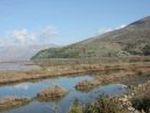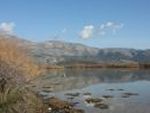|
GR074 Kalamas estuary
 |
 |
Criteria: A1, A4i, B1i, C1, C2, C3, C6
Coordinates:
39o 32' N
20o 11' E
()
|
Altitude: 0-509 m
Area: 8531 ha
|
|
 |
 |
Images
Site Description
The site comprises a canal with a delta of mudflats, saltmarshes, and lagoons. Two low hills are covered with dense scrub. Much of the area has been reclaimed for arable farming.
 |
 |
Habitats: Artificial landscapes (48%, Arable land; Other urban and industrial areas; Perennial crops, orchards and groves), Sea/marine area (4%, Sea inlets and coastal features), Shrubland (18%, Sclerophyllous scrub, garrigue and maquis), Wetland (26%, Coastal lagoons; Mud flats and sand flats; Rivers and streams; Salt marshes)
Land use: agriculture (75%), fisheries/aquaculture (10%), tourism/recreation (5%), urban/industrial/transport (5%), water management
|
 |
 |
Protection status
National Partial International Partial
1,780 ha of IBA covered by Wildlife Refuge (Vatatsa-Divari/Igoumenitsas, 1,780 ha).
5531 ha of the IBA are covered by Special Protection Area (SPA) YGROTOPOS EKVOLON KALAMA KAI NISOS PRASOUDI(GR2120005).
Birds
This site is important for breeding, passage and overwintering waterbirds. Species of global conservation concern that do not meet IBA criteria: Aythya nyroca (passage, wintering), Haliaeetus albicilla (wintering), Aquila heliaca (wintering), Gallinago media (passage).
| Species | Season | Year | Min | Max | Acc | Criteria |
|---|
| Numenius tenuirostris Slender-billed Curlew | passage | 1997 | 2 | - | good | A1, C1
|
| Sterna albifrons Little Tern | breeding | 1992 | 40 | - | unknown | C6
|
| Aquila clanga Greater Spotted Eagle | winter | 1996 | - | 7 | good | A1, C1
|
| Phalacrocorax pygmeus Pygmy Cormorant | winter | 1988 | - | 65 | good | A1, C1
|
| Phalacrocorax carbo Great Cormorant | winter | 1995 | 58 | 1017 | good | B1i, C3
|
| Casmerodius albus Great Egret | winter | 1993 | - | 219 | good | A4i, B1i, C2
|
| Plegadis falcinellus Glossy Ibis | passage | 1996 | 445 | - | good | A4i, B1i, C2
|
| Pelecanus crispus Dalmatian Pelican | winter | 1996 | 1 | 22 | unknown | A1, C1
|
| Calandrella brachydactyla Greater Short-toed Lark | breeding | 0 | - | - | unknown | C6
|
|
Conservation issues
The main threats come from habitat destruction and water pollution as a result of expanding intensive agriculture, road construction, over-grazing and hunting. The area is a candidate SAC.
 |
 |
Threats:
agricultural intensification/expansion (high), burning of vegetation (medium), drainage (medium), infrastructure (medium), recreation/tourism (low), unsustainable exploitation (high)
|
 |
 |
Source:
Copyright © Hellenic Ornithological Society
|
|

Do you know the area?
Send us your comments at iba@ornithologiki.gr
If you have noticed serious damage to the area and you want to report it please click here
 
|






